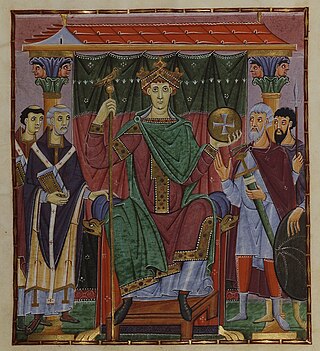Related Research Articles

The Ottonian dynasty was a Saxon dynasty of German monarchs (919–1024), named after three of its kings and Holy Roman Emperors named Otto, especially its first Emperor Otto I. It is also known as the Saxon dynasty after the family's origin in the German stem duchy of Saxony. The family itself is also sometimes known as the Liudolfings, after its earliest known member Count Liudolf and one of its most common given names. The Ottonian rulers were successors of the Germanic king Conrad I, who was the only Germanic king to rule in East Francia after the Carolingian dynasty and before this dynasty.
The 970s decade ran from January 1, 970, to December 31, 979.

Otto III was Holy Roman Emperor from 996 until his death in 1002. A member of the Ottonian dynasty, Otto III was the only son of the Emperor Otto II and his wife Theophanu.

Otto II, called the Red, was Holy Roman Emperor from 973 until his death in 983. A member of the Ottonian dynasty, Otto II was the youngest and sole surviving son of Otto the Great and Adelaide of Italy.

Year 978 (CMLXXVIII) was a common year starting on Tuesday of the Julian calendar.

Ulrich of Augsburg, sometimes spelled Uodalric or Odalrici, was Prince-Bishop of Augsburg in the Holy Roman Empire. He was the first saint to be canonized not by a local authority but by the pope.

Gisela of Burgundy, a member of the royal Elder House of Welf, was Duchess of Bavaria from about 972 to 976 and again from 985 to 995, by her marriage with Duke Henry the Wrangler. She was the mother of Emperor Henry II.

Henry II, called the Wrangler or the Quarrelsome, a member of the German royal Ottonian dynasty, was Duke of Bavaria from 955 to 976 and again from 985 to 995, as well as Duke of Carinthia from 989 to 995.

Otto I was the Duke of Swabia from 973 and Duke of Bavaria from 976. He was a member of the Ottonian dynasty, the only son of Duke Liudolf of Swabia and his wife Ida, and thus a grandson of the Emperor Otto I and his Anglo-Saxon wife Eadgyth. His sister Mathilde was the abbess of Essen Abbey.

The Duchy of Swabia was one of the five stem duchies of the medieval German Kingdom. It arose in the 10th century in the southwestern area that had been settled by Alemanni tribes in Late Antiquity.

Otto I, called Otto of Worms, a member of the Salian dynasty, was Duke of Carinthia from 978 to 985 and again from 1002 until his death.

Diocese of Augsburg is a Latin diocese of the Catholic Church in Germany. The diocese is a suffragan of the Archdiocese of Munich.

The War of the Three Henries was a brief rebellion of three German princes, all called Henry, against Emperor Otto II in 976–977, with a final peace imposed in 978. The three Henries were: Henry I, Bishop of Augsburg, Henry II, Duke of Bavaria, and Henry I, Duke of Carinthia.
Henry III, called the Younger, a member of the Luitpolding dynasty, was the first Duke of Carinthia from 976 to 978, Duke of Bavaria from 983 to 985 and again Duke of Carinthia from 985 to 989.

The Battle of Stilo was fought on 13 or 14 July 982 near Crotone in Calabria between the forces of Holy Roman Emperor Otto II and his Italo-Lombard allies and those of the Kalbid emir of Sicily, Abu'l-Qasim, who had declared a holy war against the Germans. Some sources claim that the Muslims received support from the Byzantines, in retaliation for Otto's invasion of their province of Apulia, but this is unconfirmed.

The Prince-Bishopric of Augsburg was one of the prince-bishoprics of the Holy Roman Empire, and belonged to the Swabian Circle. It should not be confused with the larger diocese of Augsburg, over which the prince-bishop exercised only spiritual authority.

Otto I, traditionally known as Otto the Great, or Otto of Saxony, was East Frankish king from 936 and Holy Roman Emperor from 962 until his death in 973. He was the eldest son of Henry the Fowler and Matilda of Ringelheim.

Henry IV was Holy Roman Emperor from 1084 to 1105, King of Germany from 1054 to 1105, King of Italy and Burgundy from 1056 to 1105, and Duke of Bavaria from 1052 to 1054. He was the son of Henry III, Holy Roman Emperor—the second monarch of the Salian dynasty—and Agnes of Poitou. After his father's death on 5 October 1056, Henry was placed under his mother's guardianship. She made grants to German aristocrats to secure their support. Unlike her late husband, she could not control the election of the popes, thus the idea of the "liberty of the Church" strengthened during her rule. Taking advantage of her weakness, Archbishop Anno II of Cologne kidnapped Henry in April 1062. He administered Germany until Henry came of age in 1065.

Henry II, also known as Saint Henry the Exuberant, Obl. S. B., was Holy Roman Emperor from 1014. He died without an heir in 1024, and was the last ruler of the Ottonian line. As Duke of Bavaria, appointed in 995, Henry became King of the Romans following the sudden death of his second cousin, Emperor Otto III in 1002, was made King of Italy in 1004, and crowned emperor by Pope Benedict VIII in 1014.
References
- ↑ "Heinrich I. Bischof von Augsburg (973-982)". manfred-hiebl.de. Retrieved 30 September 2018.
 This article incorporates text from a publication now in the public domain : Herbermann, Charles, ed. (1913). "Augsburg". Catholic Encyclopedia . New York: Robert Appleton Company.
This article incorporates text from a publication now in the public domain : Herbermann, Charles, ed. (1913). "Augsburg". Catholic Encyclopedia . New York: Robert Appleton Company.